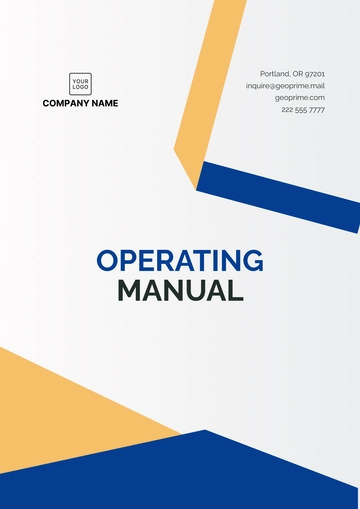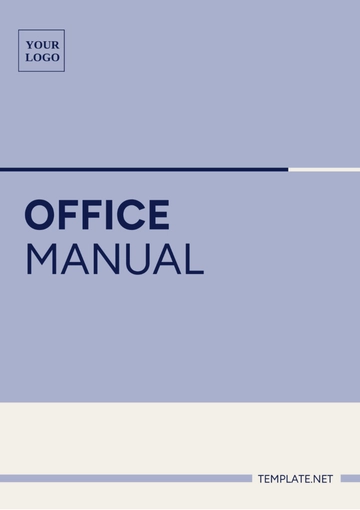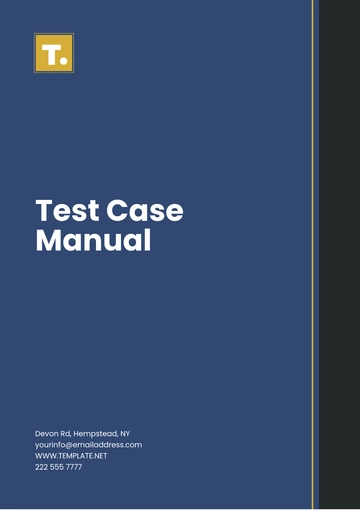Free Aesthetic Bakery Compliance Manual

I. Introduction
In the bakery industry, where visual appeal and presentation are as critical as taste, maintaining high aesthetic and compliance standards is paramount. The Aesthetic Bakery Compliance Manual for [Your Company Name] serves as a foundational guide to ensure that every aspect of our bakery's operations, from the kitchen to the storefront, aligns with our commitment to excellence. This manual not only addresses the visual and sensory elements of our products but also integrates rigorous compliance with US laws and standards to guarantee the safety and satisfaction of our customers.
Purpose
The purpose of this manual is to provide comprehensive guidelines and standards for maintaining the highest level of aesthetic quality and compliance within [Your Company Name]. This document aims to ensure that all bakery operations, including production, presentation, and sales, consistently meet our premium bakery experience criteria. By adhering to these standards, we ensure that every customer enjoys a visually appealing, delicious, and safe product, reinforcing our reputation for excellence and attention to detail.
Scope
This manual applies to all employees, contractors, and stakeholders engaged in any aspect of the esteemed organization's bakery operations. This includes individuals involved in the sourcing of ingredients, production processes, quality control, packaging, and sales. By following the guidelines outlined in this manual, all parties will contribute to upholding the bakery's aesthetic standards and compliance with relevant US laws and regulations. This ensures a unified approach to delivering high-quality bakery products that meet our brand’s standards and legal requirements.
II. Regulatory Requirements
Ensuring compliance with regulatory requirements is fundamental to the operation of the esteemed organization. This section outlines the essential federal, state, and local regulations that must be adhered to to maintain the highest standards of safety, hygiene, and quality in our bakery operations.
A. Federal Regulations
Food and Drug Administration (FDA)
The FDA oversees food safety regulations that apply to bakeries. Compliance with the Food Safety Modernization Act (FSMA) is mandatory. Key requirements include:
Preventive Controls: Establish and implement a food safety plan that includes hazard analysis, preventive controls, monitoring, and corrective actions.
Good Manufacturing Practices (GMPs): Adhere to GMPs for maintaining sanitary conditions in the production environment.
Labeling: Ensure accurate labeling of all products, including ingredients, nutritional information, and allergen disclosures.
B. Occupational Safety and Health Administration (OSHA)
OSHA regulations are designed to ensure a safe working environment for employees. Compliance involves:
Workplace Safety: Implement safety protocols to prevent accidents and injuries, including proper equipment handling and ergonomic practices.
Training: Provide comprehensive training on safety procedures and emergency response.
C. State and Local Regulations
Each state and local jurisdiction may have specific regulations that apply to bakery operations. It is crucial to stay informed about and comply with these requirements.
State Department of Health
State health departments enforce food safety regulations that complement federal standards. Compliance includes:
Health Inspections: Regular health inspections to ensure sanitary conditions and compliance with state-specific food safety laws.
Permits and Licenses: Obtain necessary permits and licenses to operate a bakery.
Local Regulations
Local health departments may impose additional requirements. Compliance involves:
Zoning Laws: Adhere to local zoning laws that dictate where bakeries can operate.
Waste Management: Implement proper waste disposal methods to comply with local environmental regulations.
D. Allergen and Labeling Compliance
Allergen Control
To protect customers with allergies, implement strict allergen control measures:
Segregation: Prevent cross-contamination by segregating allergenic ingredients.
Cleaning Protocols: Follow thorough cleaning protocols to remove allergens from equipment and surfaces.
Labeling Standards
Accurate labeling is essential to inform customers about the contents of our products:
Ingredient List: Provide a complete list of ingredients on product labels.
Allergen Warnings: Clearly label any potential allergens.
Regular Audits and Inspections
To ensure ongoing compliance, conduct regular internal audits and inspections. This includes:
Routine Audits: Perform regular audits of the production process, storage areas, and sales floor to identify and rectify potential compliance issues.
Third-Party Inspections: Engage third-party inspectors to provide an objective assessment of our compliance status.
the esteemed organization guarantees the production of safe, high-quality bakery goods that satisfy all legal criteria and safeguard the well-being of our clients and staff by abiding by these regulatory regulations.
III. Aesthetic Standards
Creating an exceptional bakery experience involves not only delivering high-quality products but also ensuring that every visual element reflects our brand’s identity. This section details the aesthetic standards required for product presentation and store layout at the esteemed organization. Adhering to these standards ensures that our bakery products are not only delicious but also visually appealing and that our store environment is inviting and well-maintained. By following these guidelines, we maintain the premium image of our brand and enhance the overall customer experience.
A. Product Presentation
Products must be presented in a visually appealing manner conforming to our brand's aesthetic guidelines. This includes:
Uniformity in Shape and Size: Ensure that all products are consistent in shape and size to reflect high standards of craftsmanship and quality.
Properly Themed Decorations: Use decorations that align with seasonal themes, promotional events, and overall brand identity to enhance the visual appeal.
Clean and Attractive Packaging: Packaging should be clean, well-designed, and reflective of the product’s quality and the brand’s image, with clear labeling and an attractive presentation.
B. Store Layout
The layout of the bakery must ensure an inviting and clean atmosphere. Key points include:
Clear and Attractive Display of Products: Arrange products in a way that highlights their quality and appeal, with well-organized displays that attract customers and make products easy to view.
Neat Arrangement of Seating Areas: Seating areas should be comfortably arranged, with a focus on cleanliness and accessibility, creating a welcoming environment for customers.
Regular Maintenance and Cleanliness: Maintain a high standard of cleanliness throughout the store, including regular cleaning of surfaces, fixtures, and equipment, to ensure a hygienic and pleasant shopping experience.
IV. Employee Responsibilities
Ensuring the success and reputation of the esteemed organization relies heavily on the performance and professionalism of our employees. This section outlines the essential responsibilities of our staff, focusing on training, hygiene, and dress code. By adhering to these standards, employees will contribute to the bakery’s commitment to excellence, maintain a high level of compliance with our aesthetic guidelines, and provide exceptional customer service. These measures are crucial for sustaining a safe, professional, and appealing environment for both our customers and staff.
A. Training
All employees must undergo comprehensive training to understand compliance standards, aesthetic guidelines, and customer service protocols. This training includes:
Compliance Education: Detailed instruction on federal, state, and local regulations related to food safety, health, and safety standards.
Aesthetic Guidelines: Training on the bakery's specific aesthetic standards for product presentation, store layout, and branding.
Customer Service Skills: Instruction on delivering excellent customer service, including effective communication, handling customer inquiries and complaints, and creating a positive customer experience.
B. Hygiene and Dress Code
Strict dress codes and hygiene standards must be maintained to ensure a professional appearance and high levels of food safety. This includes:
Wearing Clean Uniforms: Employees must wear clean, well-maintained uniforms at all times to present a professional image and maintain hygiene.
Regular Hand Washing: Employees are required to wash their hands frequently and thoroughly, particularly before handling food, after using the restroom, and after any activity that may contaminate their hands.
Using Proper Protective Gear While Handling Food: Employees must use appropriate protective gear, such as gloves and hairnets when handling or preparing food to prevent contamination and ensure safety.
V. Quality Control
Quality control is integral to ensuring that the esteemed organization consistently delivers bakery products that meet our high standards for taste, appearance, and safety. This section outlines the procedures and practices required to maintain exceptional quality and adhere to both aesthetic and regulatory standards.
A. Product Inspection
Regular product inspections are crucial to maintaining quality. The following procedures must be followed:
Visual Inspection: Conduct visual checks to ensure that products meet our aesthetic standards, including uniformity in shape and size, proper decoration, and clean packaging. Products that do not meet these standards should be corrected or discarded.
Taste Testing: Implement a systematic taste testing process to ensure that the flavor, texture, and freshness of products are consistent with our quality expectations. This involves sampling products at various stages of production and from different batches.
B. Production Standards
To maintain high production standards, the following practices must be adhered to:
Recipe Consistency: Use standardized recipes and procedures for all products to ensure consistency in flavor, texture, and appearance. Any deviations should be documented and analyzed.
Ingredient Quality: Source high-quality ingredients and verify their freshness and safety. Inspect ingredients upon delivery and reject any that do not meet our quality criteria.
Equipment Maintenance: Regularly maintain and calibrate production equipment to ensure it operates correctly and produces products to our specifications. Schedule routine maintenance checks and address any issues promptly.
C. Employee Training and Monitoring
Effective quality control involves continuous training and monitoring of employees:
Ongoing Training: Provide regular training sessions to ensure that employees are up-to-date with quality control procedures, including any changes in production methods or standards.
Performance Monitoring: Implement a system for monitoring employee performance about quality control. This includes regular evaluations and feedback to maintain high standards.
D. Documentation and Reporting
Accurate documentation and reporting are essential for quality control:
Record Keeping: Maintain detailed records of production processes, ingredient batches, inspection results, and any deviations from standards. This documentation is critical for tracking quality and identifying areas for improvement.
Issue Reporting: Establish a protocol for reporting and addressing quality issues. Employees should be encouraged to report any problems immediately so that corrective actions can be taken swiftly.
E. Continuous Improvement
Quality control is an ongoing process that requires continuous improvement:
Feedback Loop: Regularly review feedback from customers and staff to identify areas for improvement. Use this feedback to make necessary adjustments to processes and standards.
Quality Audits: Conduct periodic quality audits to assess adherence to standards and identify opportunities for enhancement.
VI. Appendices
This section provides additional resources and essential information to support the implementation and understanding of the Aesthetic Bakery Compliance Manual. The appendices include a glossary of key terms used throughout the manual and important contact information for addressing any questions or concerns. These resources are designed to offer clarity and facilitate effective communication, ensuring that all stakeholders have access to the necessary tools and support to uphold the standards and practices outlined in this manual.
A. Glossary of Terms
The following glossary defines key terms used throughout the manual. Understanding these definitions will help ensure clarity and consistency in the application of aesthetic and compliance standards at the esteemed organization.
Term | Definition |
|---|---|
Aesthetics | The set of principles concerned with the nature and appreciation of beauty, especially in art. |
Compliance | Conformity in fulfilling official requirements. |
B. Contact Information
Please contact [Your Name] for any questions or concerns regarding compliance:
Email: [Your Company Email]
Phone: [Your Company Number]
- 100% Customizable, free editor
- Access 1 Million+ Templates, photo’s & graphics
- Download or share as a template
- Click and replace photos, graphics, text, backgrounds
- Resize, crop, AI write & more
- Access advanced editor
Maintain regulatory standards with the Aesthetic Bakery Compliance Manual Template from Template.net. This fully editable and customizable template provides a detailed format for documenting compliance procedures. Easily personalize it using our Ai Editor Tool to create a professional manual that ensures your bakery meets all regulatory requirements effectively.





























